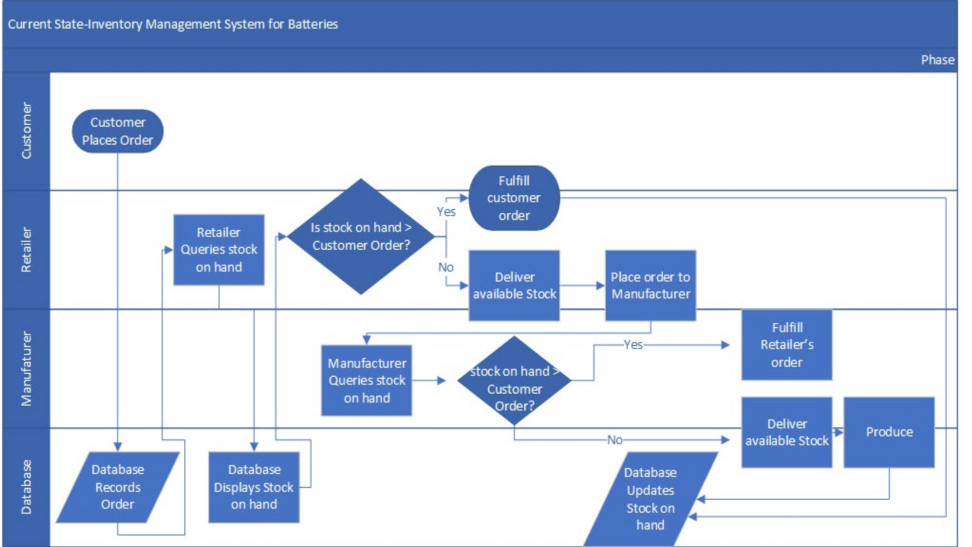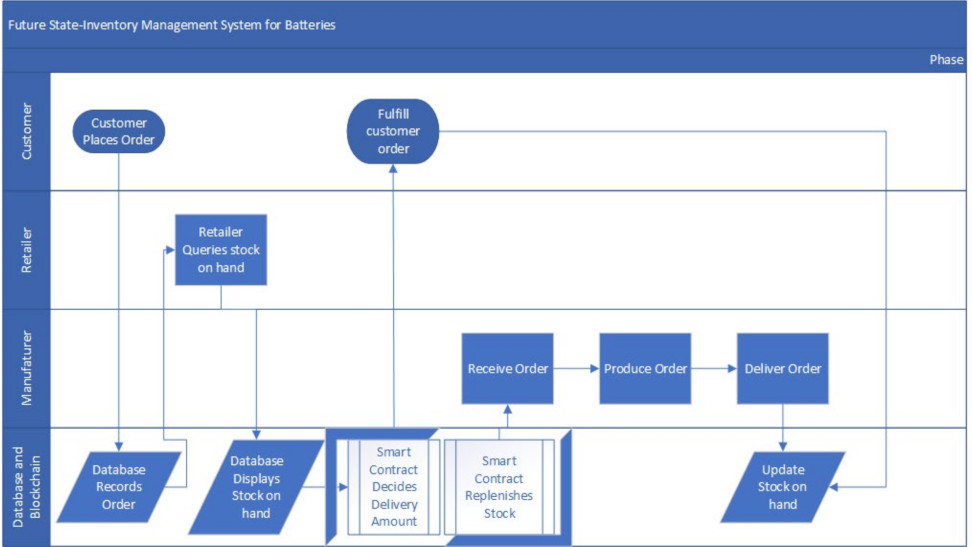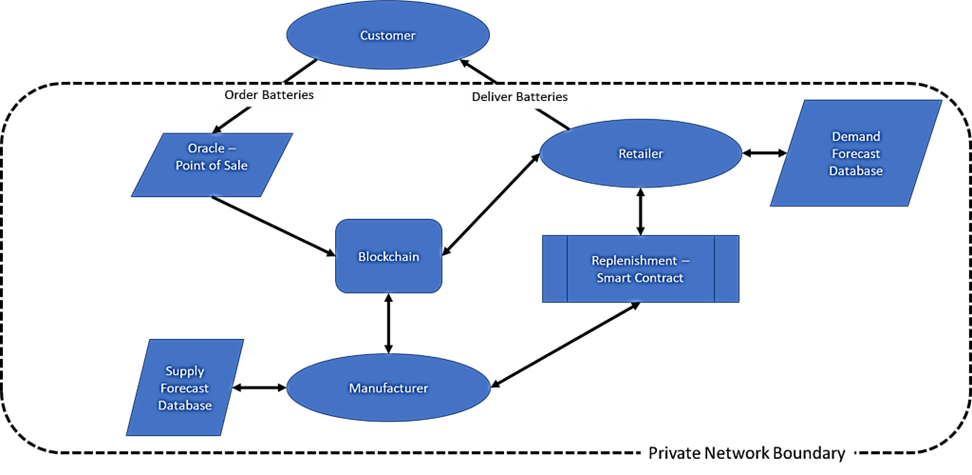Inventory has been managed predominantly over enterprise resource planning (ERP) systems over past couple of decades. The widespread adoption of ERP systems ranges from multinational corporations to brick-and-mortar retailers. However, 75% of such ERP projects fail post-implementation due to a variety of reasons, according to Gartner. These reasons stem from reactive inventory planning and replenishment processes and in response to fluctuating and unpredictable market demand.
Supply chain partners or buyer-supplier collaborations operate in silos, leading to error-prone forecasting and bureaucratic order management. As a buyer discovers that customer demand couldn’t be met because of a lack of sufficient inventory, or, similarly, as a supplier discovers that inventory costs are too high because of large product stock, both the actors incur revenue losses in spite of a seamless ERP system. This results in a lack of trust between the partners and a loss of transparency.
Need for a blockchain
When the mismatch between product supply and market demand escalates over a period of time, revenue losses are magnified exponentially. Distorted information regarding market forecast and product supply lead to tremendous inefficiencies, evident from poor customer service, high transportation costs, high inventory costs, misguided capacity plans, etc. This phenomenon of the bull whip effect is highly likely to occur in cases of high-velocity products such as a battery in an electric car. With focused efforts from environmentalists, technologists and government incentives, a positive consumer sentiment toward electric cars is expected to lead to an exponential market demand for batteries. However, an overly optimistic market outlook results in inflated forecasts, which are later discovered to be inaccurate. Thus, refining inventory management of electric car batteries is of prime importance.
A blockchain-based system outperforms the ERP system in numerous ways due to its decentralized and immutable nature:
1. Blockchain enables actors to function in an open environment through decentralized inventory management process.
2. Unlike ERP that features a single authoritarian or even dictatorial control at times, blockchain enables multi-stakeholder control.
3. Data governed through ERP data is more insecure than that through blockchain, since information manipulation, intentionally or accidentally, is not possible in a blockchain-based system.
4. Technological updates are quicker in blockchains.
5. All the actors in a blockchain-based system possess clear understanding of their roles and responsibilities, resulting in high transparency, compared to ERP system.
6. Since the data source, owner and stakeholder are the same actors in a blockchain, information reliability is higher than that of an ERP system.
7. Integrating and synchronizing the system through combining its parts doesn’t require separate efforts as all the external and internal stakeholders are highly aligned with the system sponsor.
Thus, electric car battery inventory will be better managed through a blockchain-based system.
Current state
The current supply chain system involves multiple phases starting with suppliers and producers, to warehousing, and retailers. Access to data at each phase will use a different enterprise resource planning (ERP) and inventory management software to manage inventory. These data silos typically do not communicate with one another causing disconnects which make it difficult for managers to properly forecast demand, plan production and deliver adequate replenishment inventory. Information silos at each level result in an inadequate data transparency and without true visibility into consumer demand. A lack of trust in management businesses make it difficult to gauge the supply and demand upstream and downstream in the supply chain.
These imbalances result in greater costs and lower profits due to inaccurate replenishment, excess inventory, and stock out. Demand is constantly fluctuating; the number of SKUs are growing at a high rate and manufacturing lead times are extended. To overcome these challenges, companies need visibility and transparency into customer demand and the inventory management process to be able to connect the entire process and access trusted data through blockchain technology.
“Eighty percent of in-market ERP solutions only provide warehouse-level planning. The other 20% do not incorporate store-level demand,” Ray Young wrote in 2018. Blockchain technology will provide real-time inventory visibility for management to be able to control inventory performance at each phase of the inventory management system and will save countless hours of work associated with data entry, organization and order fulfillment.
Inventory management performance dictates the survival of not just businesses but entire industries. For our purposes, we will be focusing on four major players: the customer, retailer, manufacturer and the individual databases that house the necessary information accessible by retailers and manufacturers. We’ll first focus on the current landscape and the “disruptions in these systems [that] can also lead to serious problems in a supply chain.” Inventory planning, forecasting, and replenishment is operated under a retroactive model where it has become a major challenge. Since demand is a constant flux, manufacturers must resort to wider arrays of products and SKUs (stock keeping units) to meet demand. The growth in number of SKUs have led to an exponential rise in manufacturer lead times.
Supply and demand imbalances
The primary point of concern stems from an imbalance of supply and demand between retailer and manufacturer. The retailer houses its own inventory management database that records on-hand counts while manufacturers silo themselves with their own proprietary databases. The result of these individual databases come in the form of over- or under-production by the manufacturer based on inventory on hand, which both lead to excess cost. To put this in real-world terms, we’ll break down the step-by-step actions of each actor.
As depicted in figure 1, the current state starts with the customer placing an order at the retail location. The retailer’s database records the order and then queries the stock on hand. The database then displays the stock on hand to the retailer and deciphers if the stock on hand is greater than the customer’s order. If it is, then the customer’s order gets fulfilled. If the supply on hand is less than the stock on hand, it places an order to the manufacturer and the assumption here is that the database delivers an available stock to the customer. Once the manufacturer receives the order from the retailer, it’s database queries the stock on hand. If the manufacturer’s stock on hand is greater than the retailer’s order, it proceeds with fulfillment. If the stock on hand is less, then it proceeds to deliver an available stock but then proceeds to produce and manufacture the item to its own acceptable inventory levels while updating its own database with current inventory levels. This continuous lack of visibility into consumer demand leads to both retailer and manufacturer’s inventory management tools being antiquated and relies on human intervention to coordinate proper forecasting. Trust is then resorted to the manufacturer’s operational leadership team but as ManMohan Sodhi mentions, “most supply chains have become more complex and consequently more vulnerable to disruptions such as demand fluctuations.”

(Figure 1: Current State Process Flow Map of Battery Inventory Management System)
Blockchain for inventory planning, replenishment and forecasting
Blockchain technology positively impacts numerous industries by offering accurate ways to digitize all inventory transactions on a secure ledger by providing visibility, trust and transparency for the entire business. In our example, supply chain managers will be able to trace the electric car battery inventory process using permanent records stored on the blockchain. These transactions are consolidated and reachable, offering the clarity needed to apportion assets effectively in real-time data flow. With increased accuracy and visibility throughout the network, managers will be able to access potential shortfalls in meeting customer’s demand or overstock, replenishment and forecast to promote business growth and profitability. Inventory will always be available to satisfy customers by eliminating lost sales, minimizing carrying costs and increasing revenue and profitability.
Having a secure decentralized ledger will make it nearly impossible to hack or alter logged data. Data will be available across the entire inventory management network and no activity can alter the system. Managers will be able to access the data to perform accurate planning, replenishment and forecasting, centered on network requirement. The blockchain assumes lead time, purchase price for each item and cost of the ordering remains constant. Also, no cash or settlement discounts are available. The optimal plan is calculated for only one product. And lastly there is no delay in the replenishment of the stock, and the order is delivered in the quantity that was demanded, i.e. in whole batch.
Future state
With the involvement of blockchain and smart contracts, we mitigate lead times and control inventory management at a far superior level than indicated in the current state. Blockchain can help drive business growth with complete transparency and real-time data flow from end to end. In our future state, depicted in figure 2, the customer placing the order initiates the retailer’s database and shared blockchain to record the order, while the retailer’s database queries the stock on hand. The blockchain then displays what available inventory supply looks like to the retailer. The smart contract would then get applied and take over the decision process for the delivery amount to the customer. If the retailer’s supply on hand is shorter than the customer demand, the smart contract will release available inventory to the customer while also requesting a replenishing stock amount by the manufacturer. The difference here in the future state is the smart contract requests the replenishment even if the stock on hand is not depleted. The smart contract will have established thresholds to not surpass and if done so, will automatically send a request to the manufacturer for replenishment. The manufacturer will receive the order, produce it, and deliver it, all while updating its inventory database and blockchain. This method will help optimize the manufacturing levels upstream in the supply chain to meet consumer demands downstream all in the pursuit of sustainability. This level of visibility and transparency can reduce demand volatility and inaccurate forecasts which then affect future inventory supplies due to the bullwhip effect.

(Figure 2: Future State Process Flow Map of Battery Inventory Management System)
Blockchain-based governance
Figure 3 presents a high-level architecture of our envisioned blockchain-based inventory management system. Our future state blockchain will be a private network only accessible by retailers and manufacturers. This will be followed by a permissioned-view access by retailer and view/edit access by manufacturers to allow control over on-hand inventory fluctuations. The blockchain will operate parallel to the retailer’s and manufacturer’s own databases if they so choose. Given that the manufacturers have view/edit access, consensus must be obtained between retailer and manufacturer for any desired changes to the blockchain and smart contracts will be established as the reordering mechanism.

(Figure 3: Blockchain based Inventory Management Architecture)
The oracles for the entire ecosystem will be the point-of-sale terminals at the retail location. This blockchain will not utilize a token or cryptocurrency facet in its utilization. The consensus mechanism utilized in this blockchain application will be on a proof-of-work basis. Here, the manufacturer will apply its computational power in order to write and update the transactions to each block. Each transaction will include date, time, SKU and count of items that change in the inventory database. The retailer will have access to view the updated blocks while the manufacturer may edit the transaction if needed based on stock. Multiple transactions over a fixed periodic interval will be added in a block, which will be encrypted through SHA-256 hash algorithm. A new block will be added once the retailer, as well as manufacturer, verify the timestamps on the latest transactions, and match the identifying keys in the SHA 256 hash algorithm.
About the author:
Kiran S Patil is a PhD candidate in supply chain management at the University of North Texas’ G. Brint Ryan College of Business. He can be reached at [email protected].
SC
MR


More Inventory Management
- When disaster strikes, the supply chain becomes the key to life
- Why we can’t ignore inventory rightsizing in industrial sectors
- Building resilience in manufacturing
- One door closes, a better one opens
- AI liftoff delayed?
- The key to good data management? Start with good data
- More Inventory Management
Latest Podcast

 Explore
Explore
Topics
Procurement & Sourcing News
- AI-driven sourcing: Why the speed of change is going to only accelerate
- A Silk Road city
- U.S.-bound containerized import shipments are up in June and first half of 2024
- Boeing turned to Fairmarkit, AI to help land its tail spend
- When disaster strikes, the supply chain becomes the key to life
- A smarter approach to sustainability is vital for healthy, resilient supply chains
- More Procurement & Sourcing
Latest Procurement & Sourcing Resources

Subscribe

Supply Chain Management Review delivers the best industry content.

Editors’ Picks




